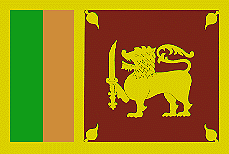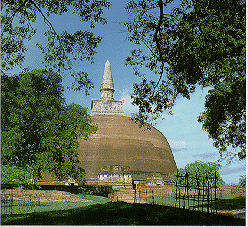
| GENERAL
INFORMATION OF
SRILANKA
|
 |


The recorded history of Ceylon begins with the legendary story of the landing of Prince Vijaya and his 700 followers from a kindom in north-western India in the 6th century BC. The Sinhala people who today comprise 71 precent of the population are descendants of this Indian settlement. Historians surmise that the truth behind the legend is that Aryan settements in Ceylon were established at that time by enterprising groups of merchants and traders. It is generally accepted that prior to thee settlements there were no people in the country with an advanced civilization. But some archeologist and historians think otherwise. It is however cetin that there were group of people who may be describe as aborigines. They were hunting tribes and used simple implement of quartz, wood and animal bones. The veddas of today are supposed to be descendants of these tribes.
During the 5th and 4th centuries BC Ceylon was extencively colonized by these Indo Aryans. The Cgronology of Ceylon's history can be established firmly with the reign of King Devanampiyatissa (250-210 BC) who was a contemporary of Emperor Asoka of India. One preceding king deseves mention here King Pandukhabaya who founded the city of Anuradhapura which was to be the royal capital for over a millennium.
![]() Overview
Overview
The Name conjures up images of a land rich in heritage, and culture.
Sri Lanka is an island in the Indian Ocean 50km (31 miles) off the southern tip of India![]() Climate
Climate![]() Tourist information of Sri Lanka
Tourist information of Sri Lanka ![]() Brief History
Brief History![]() National Anthem
National Anthem![]() National Flag
National Flag![]() National Flower
National Flower![]() State Emblem
State Emblem![]() National Tree
National Tree![]() Offical name
Offical name![]() Form of government
Form of government![]() Population (millions)
Population (millions)![]() Populatin density (people/1 square km)
Populatin density (people/1 square km)![]() Literacy rate
Literacy rate![]() Ethnicty
Ethnicty![]() Offical languages
Offical languages![]() Religions
Religions![]() Capital
Capital![]() Colombo Exchange rates(at 3/6/'95)
Colombo Exchange rates(at 3/6/'95)
Currency per Unit S.L.Rs.
Buying Selling
1 US Dollars 50.17 50.39
1 Sterling Pounds 78.96 79.76
1 Deutsche Mark 35.73 36.28
1 French Francs 10.13 10.37
100 Japanese Yen 58.44 59.36